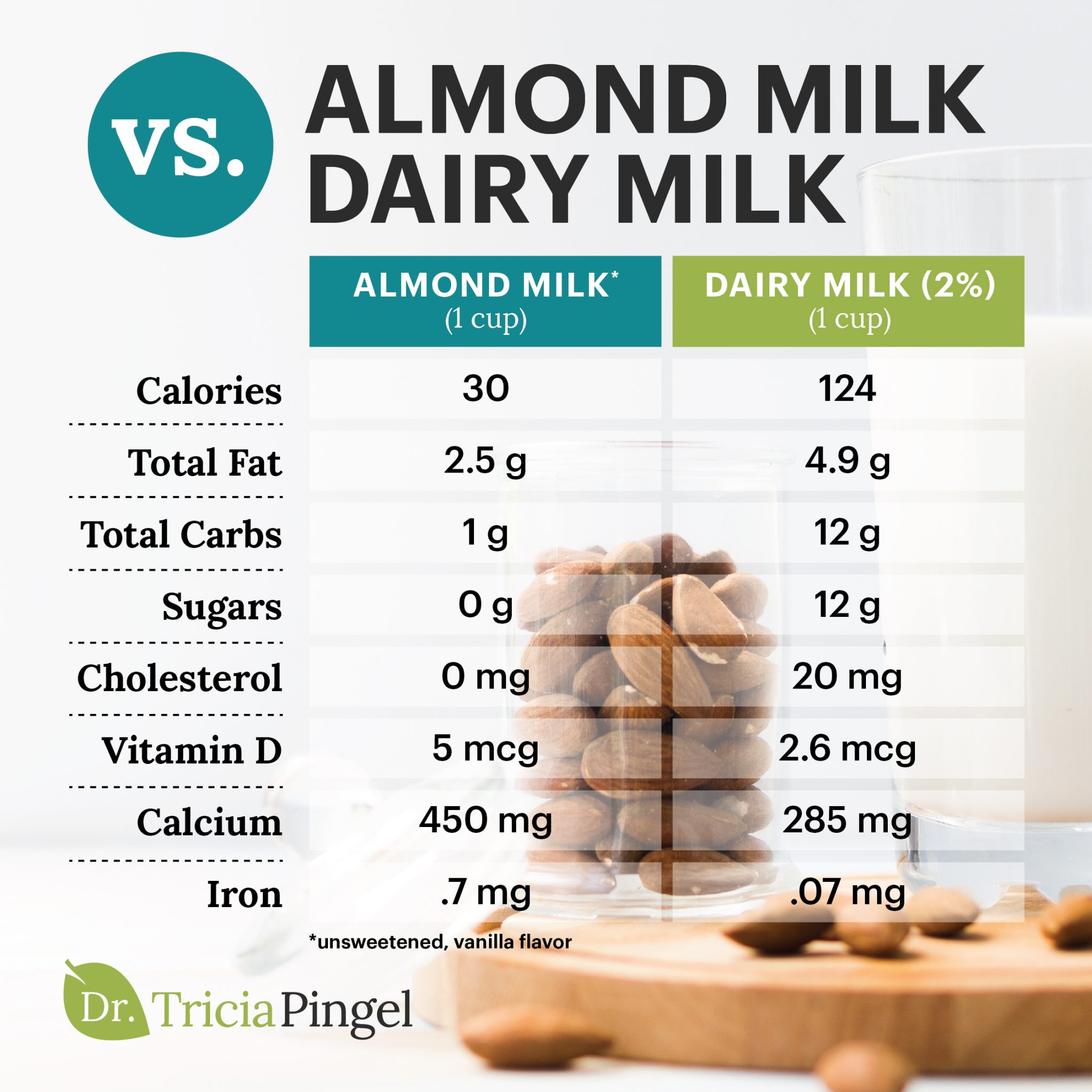The Amazing Nutritional Benefits of Almonds: How These Powerful Nuts Support Blood Sugar, Weight Management, and More!
I firmly believe in the concept of food as medicine. As an expert on adrenal fatigue and chronic stress, I know that when you fill your body with nutrients, amazing, wonderful things can happen. I’ve seen patients lower their inflammation, curb their hunger, and even reverse serious diseases by tapping into the power of nutritional foods. And one amazing example of this lies in the nutritional benefits of almonds.
While you may have heard about the well-established connection between almond consumption and weight management, you might be surprised to learn that the nutritional benefits of almonds extend to supporting the health of your heart, blood sugar, and gut. But what makes almonds such a power-packed health food? Let’s dive in and learn all about this superfood and how you can make the most of it! (Hint: It’s the perfect base for many dishes!)
Why Almonds Are So Healthy
In order for us to discuss what makes almonds so healthy, we must first look at their nutritional profile.
Almonds contain numerous nutrients, but, first and foremost, they are a great source of vitamin E, which has been shown to fight damaging oxidative stress in the body. [1] As you may be aware, oxidative stress has been linked to the development of many diseases, including some cancers, Alzheimer’s, Parkinson’s, fatty liver disease, atherosclerosis, and more. [2] This makes vitamin E (which can only be obtained through the diet) a vital nutrient to consume on a regular basis.
But that’s not all that almonds offer. They’re also rich in magnesium, manganese, copper, phosphorous, and riboflavin. Moreover, they’re a great source filling fiber and energy-boosting protein as well as unsaturated fatty acids, which have also been linked to a lower risk of heart disease and other health conditions. [3]
In addition to being highly nutritious, almonds are also extremely versatile. I use them as a base for many of my dairy- and gluten-free foods and beverages, such as in nut milk, sauces, flours, and more. In fact, I like to use almond flour, almond milk, and even almond butter in a variety of recipes, such as in these cookies, popsicles, and even my famous blondie loaf!
They’re not only great alternatives for those who suffer with certain food intolerances, but they’re also typically more nutritious than the standard options.
In fact, take a look at this infographic for just one example of how almond milk stacks up to the standard dairy milk. You may be surprised at just how much more almonds have to offer!

Now that we’ve reviewed the nutrient content in almonds and a few ways in which you can use them, let’s take a look and some of the top nutritional benefits of almonds.
6 Nutritional Benefits of Almonds
1. Support heart health
One of the top nutritional benefits of almonds is the fact that it supports heart health. As you may recall, heart disease is the leading cause of death in the U.S., accounting for 1 in 4 deaths every year. [4] So, this health benefit is one that’s definitely worth discussing and reviewing closer.
Interestingly, a 2018 review featuring more than 50 studies confirmed that almond consumption can help reduce the risk factors for heart disease. The review authors confirmed that adding almonds into your diet not only support healthy cholesterol levels but also reduce other important risk factors.
Specifically, they confirmed that eating around 45 grams (about 1/3 cup) of almonds each day can help reduce dyslipidemia, which is defined as having an abnormal amount of lipids in your blood. This is one of the greatest and most important risk factors of heart disease for people across the world. [5]
2. Support healthy blood sugar levels
Another one of the top nutritional benefits of almonds? They're known to support healthy blood sugar levels, largely thanks to their fat and fiber composition.
In fact, a 2012 review stated that emerging evidence, as supported by numerous studies, supports the fact that consuming almonds can improve the risk of developing chronic degenerative diseases—especially in people with metabolic syndrome and type 2 diabetes. [6]
Moreover, a 2013 study revealed that when people with an increased risk of developing type 2 diabetes consumed 43 grams of almonds each day as a snack for four weeks, the almonds lowered their post-meal serum glucose levels! [7]
3. Contain anti-inflammatory properties
It’s been well-documented that chronic inflammation often leads to many of the most prevalent health conditions and diseases we’re facing in our modern world. But, amazingly, one of the top nutritional benefits of almonds is that they actually help fight inflammation!
In a 2013 study, researchers decided to investigate the effect of almond consumption on inflammation levels in people with type 2 diabetes—a disease known for its inflammatory origins. Amazingly, the researchers found that when participants replaced 20 percent of their daily caloric intake with almonds, by eating 56 grams (a little less than 1/2 cup) daily of the nut for four weeks, they improved their inflammation levels.
Specifically, those eating almonds decreased their inflammatory markers anywhere from 10.3 percent to 15.7 percent! The researchers stated that, based on these findings, incorporating almonds into your daily diet could help improve both inflammation and oxidative stress in patients with type 2 diabetes. [8]
This is further support that people suffering from inflammation-related illnesses could benefit from regular almond consumption.
4. Help control hunger
Did you know that regularly snacking on almonds can also help control your hunger?
The same 2013 study mentioned above where almond consumption lowered post-meal glucose levels also had other interesting findings. In addition to improving their blood sugar levels, researchers found that consuming almonds as snacks also reduced participants’ hunger and their overall desire to eat! [9]
As you can see, consuming almonds on a regular basis may not only help control post-meal blood sugar spikes, but it can also help reduce binge eating by helping to control hunger.
5. Fight fat and support healthy weight management
If you're concerned about body fat or weight management, you're going to be especially interested in this: When it comes to the nutritional benefits of almonds, perhaps the most popular is its ability to fight fat and obesity.
According to a study published in 2017, almond consumption significantly benefits body fat mass. When participants ate 56 grams of almonds before a meal, they saw significant improvements in body fat mass, body fat percentages, and even visceral (abdominal) fat levels.
Specifically, after 16 weeks, the participants saw the following results (on average): a 10 percent decrease in body fat mass, a 35 percent decrease in body fat percentage, and a 25 percent decrease in abdominal fat! [10]
Additionally, in a 24-week trial on 65 adults classified as either overweight or obese, researchers found that consuming 84 grams (about 2/3 cup) of almonds each day resulted in an 18 percent decrease in weight! [11]
Waist circumference also decreased by 14 percent, while fat mass decreased by 30 percent. Interestingly, when compared with a group who self-selected their complex carbohydrates instead of consuming almonds, the results were staggering.
Those in the almond group had a 62 percent greater reduction in weight, a 50 percent greater reduction in waist circumference, and a 56 percent greater reduction in fat mass than the self-selecting group! How incredible is that?
6. Support gut health
At this point, it’s hard to believe there can be even more nutritional benefits of almonds, right? Well, there are actually many more, but the last one I’d like to focus on is how it supports your gut health.
As we’ve discussed before, optimal gut health is so important for your overall health, since it impacts your body’s ability to properly and adequately absorb the nutrients in your food. Well, now it looks like consuming almonds can aid this important function.
A 2018 study conducted over 15 weeks revealed that consuming almonds increased the amount of good bacteria in the gut, specifically Lachnospira, Roseburia, and Dialister. [12] Why is this important? Well, numerous studies have shown that a decrease in these beneficial bacteria are linked to an increased risk of chronic disease development!
For example, studies have shown that a decrease in the amount of Lachnospira in the gut microbiome is associated with asthma in children, Crohn's disease, and even chronic kidney disease! [13]
Almonds really are a powerhouse food, aren’t they? If you’re looking to capitalize on any of the health benefits of almonds listed above, try to consume at a few handfuls before your meals as a pre-meal snack.
You can also use almonds as the base for many sauces or even sneak some almond butter into smoothies or eat a tablespoon-full with some apples. The options—just as the health benefits—are seemingly endless.
Key Takeaways
- While you may have heard about the well-established connection between almond consumption and weight management, you might be surprised to learn that the nutritional benefits of almonds extend to supporting the health of your heart, blood sugar, and gut.
- Almonds contain numerous nutrients, including vitamin E, magnesium, manganese, copper, phosphorous, and riboflavin. Moreover, they’re a great source filling fiber and energy-boosting protein.
- Some of the top nutritional benefits of almonds include: supporting heart health, blood sugar levels, gut health, and weight management. They also fight inflammation and hunger!
- To get the most nutritional benefits of almonds, eat them as pre-meal snacks and incorporate them into some of your favorite recipes.










